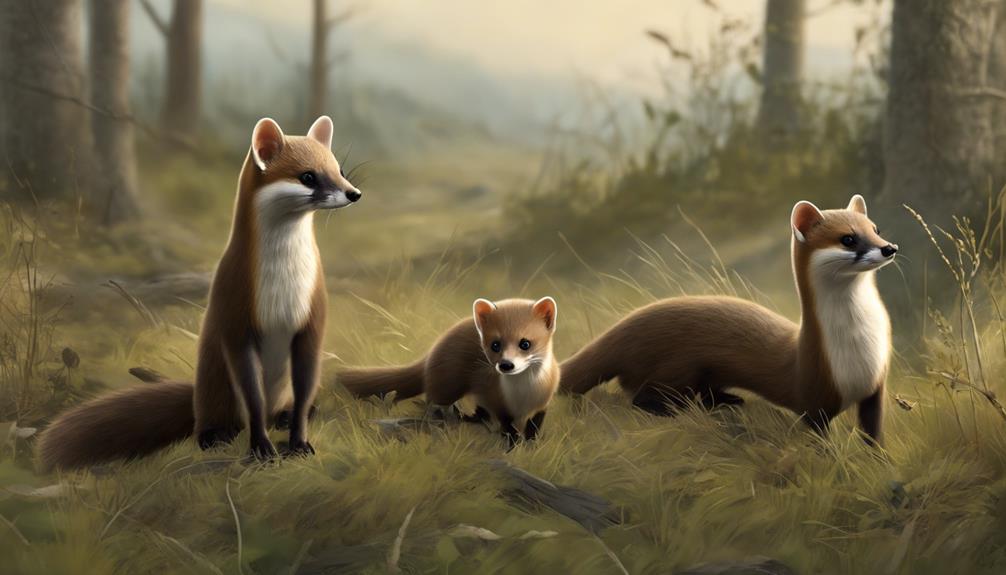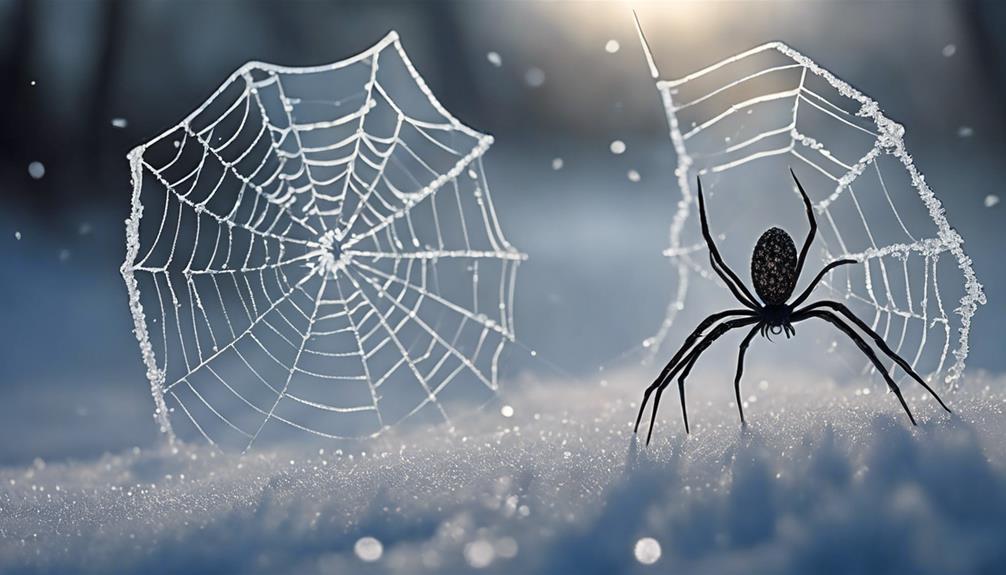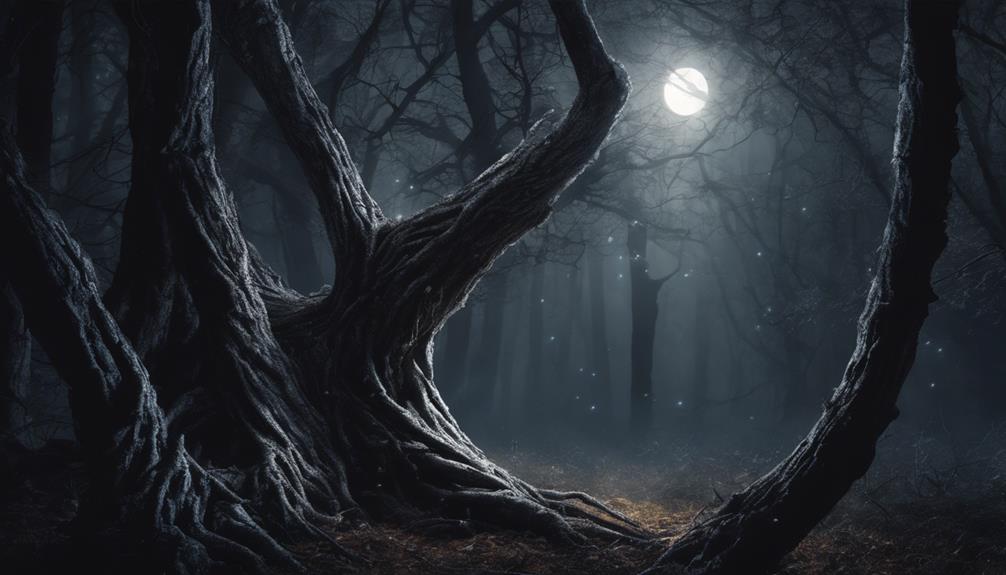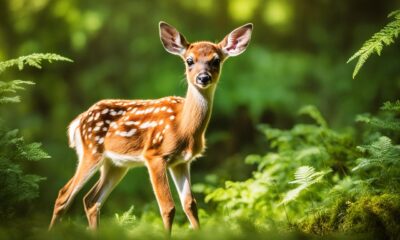Animals
Marten Vs Weasel: Spotting the 10 Key Differences
Yearning to distinguish between martens and weasels? Uncover the 10 key differences to unveil these elusive creatures' unique traits.

When figuring out the differences between martens and weasels, look at their bodies; martens are bigger with darker, bushy fur, while weasels are slinkier with shorter tails. Watch for tail length and color; martens have bushy black tails for balance, but weasels have short, brown tails for utility. Check their hunting habits too; weasels are speedy bird and rat hunters, while martens are patient and prey on eggs and insects. Pay attention to where they live; martens prefer forests, weasels thrive in various habitats. Understanding these key points helps identify these creatures, revealing more distinctive features about them.
Key Takeaways
- Martens have robust bodies, bushier dark tails, and solitary habits.
- Weasels possess shorter brown tails, sleek bodies, and active social behavior.
- Martens hunt with stealth for arboreal prey, while weasels rely on speed for ground-dwelling hunting.
- Martens prefer dense evergreen forests, weasels thrive in various environments.
- Martens communicate through scent marking, weasels use vocalizations and social behaviors.
Physical Appearance
I can differentiate between martens and weasels by observing their distinct physical appearances. Martens have a more robust body length compared to weasels, with weasels typically ranging from 20-27cm. The fur of martens is usually darker and bushier, while weasels sport shorter, stubby brown tails.
When it comes to behavior, martens are known for their shy and solitary nature, preferring mature evergreen forests as their habitat. On the other hand, weasels can adapt to various environments and are more active and bold in their actions. Additionally, weasels have a slinkier body shape, making them distinguishable from the more solidly built martens.
Tail Length and Color

In distinguishing between martens and weasels, a key feature to take into account is their tail length and color. Martens sport bushy, almost black tails that are quite distinctive. These tails aren't just for show; they play an essential role in the marten's arboreal lifestyle. When climbing trees, the tail aids in balance and agility, making it an important distinguishing feature of the marten.
On the other hand, weasels have short, stubby tails that are typically brown. Unlike the prominent tails of martens, weasels' tails are more utilitarian, suited for their ground-dwelling habits. The color and length of the tail are key physical features that can help you tell martens and weasels apart.
Hunting Techniques

When comparing martens and weasels, understanding their distinct hunting techniques sheds light on their predatory behaviors and ecological roles in their habitats. Weasels rely on their speed and agility to swiftly hunt down prey like birds, rats, and mice. Their quick movements and nimbleness make them efficient predators in capturing small animals. On the other hand, martens utilize stealth and patience to stalk and ambush their prey, which can include birds' eggs, insects, and small mammals. This method allows martens to carefully plan their attacks and secure their meals without expending unnecessary energy.
Weasels are notorious for their destructive behavior in chicken coops, where they hunt and kill poultry for food. In contrast, martens are skilled climbers and often pursue squirrels and other arboreal prey in the treetops. Additionally, weasels have high metabolisms and need to consume a large amount of food relative to their size to sustain their energetic hunting lifestyle. These contrasting hunting techniques showcase the diverse strategies employed by martens and weasels in their quest for survival.
Preferred Habitats

Martens typically seek out mature evergreen forests with plenty of hiding spots and prey.
Weasels, on the other hand, are versatile creatures that can thrive in various settings, from grasslands to urban areas.
Understanding these habitat preferences gives insight into the different lifestyles of these fascinating animals.
Weasel Habitat Description
Weasels thrive in habitats with abundant cover such as woodlands, grasslands, and brushy areas, often located near water sources like streams, ponds, or marshes. These agile hunters prey on rodents, rabbits, and small birds in these environments.
Weasels are adaptable creatures, able to live in various habitats including farmlands and suburban areas. They utilize burrows made by other animals or create their own underground dens for shelter.
Their keen hunting skills make them well-suited to areas rich in prey. By taking advantage of the cover provided by woodlands and grasslands, weasels can move stealthily to catch their next meal.
Marten Preferred Environment
Nestled amidst the dense foliage of mature evergreen forests, martens prefer habitats teeming with abundant cover and a diverse array of food sources. These elusive creatures thrive in areas with ample tree cover, such as old-growth forests and coniferous woodlands.
Martens are skilled at maneuvering through dense vegetation, utilizing their adept climbing abilities to move through their preferred environment. They're known to feed on a variety of food sources including birds' eggs, insects, small mammals, and fruits found within their habitat.
Martens establish territories within these habitats, often marking them with scent glands to delineate their space. Their solitary nature aligns with their preference for secluded areas within the rich tapestry of mature evergreen forests.
Social Behavior

Martens and weasels have distinct social behaviors.
Martens are solitary creatures, preferring to live and hunt alone.
In contrast, weasels are more social and may form small groups or colonies.
Habitat Preferences
While preferring mature evergreen forests for their habitat, martens seek dense cover and a variety of prey. On the other hand, weasels are more adaptable, being found in a range of environments such as grasslands, forests, and even urban areas. Martens are known for their solitary nature, avoiding contact with others except during the breeding season, while weasels exhibit some social behavior by overlapping home ranges and having occasional interactions with other weasels. Martens mark their territories with scent markings, whereas weasels rely heavily on their agility and speed for hunting and survival.
| Martens | Weasels | Habitat Preferences |
|---|---|---|
| Mature evergreen forests | Range of environments | Prefer dense cover |
| Solitary | Some social behavior | Mark territories with scent |
| Variety of prey | Agile hunters | Breeding season interactions |
Communication Methods
In contrast to their solitary nature in habitat preferences, weasels exhibit social behavior through vocalizations and living in groups for communication methods. Weasels use vocalizations like squeaks and chirps to communicate with one another, while martens rely more on scent marking and body language.
Weasels tend to live in groups, known as packs, where they engage in play behavior to strengthen social bonds. Unlike martens, weasels are more independent and may share territories with other group members. During mating season, martens show more complex social behaviors, whereas weasels maintain consistent social interactions throughout the year.
Understanding these communication methods sheds light on the social dynamics of these fascinating creatures.
Group Dynamics
Understanding the social behavior of these fascinating creatures reveals intriguing insights into their group dynamics.
Martens typically lead solitary lives, while weasels are more social animals that form groups with hierarchical structures. In weasel communities, dominant individuals establish territories and take the lead, unlike martens who prefer to live independently.
Weasels engage in cooperative hunting and share food within their social structure, exhibiting playful behaviors like chasing and play fighting. Martens, on the other hand, are less likely to interact socially or participate in cooperative activities.
Weasels communicate through vocalizations and body language with conspecifics, enhancing their social bonds, whereas martens rely more on their solitary instincts.
Reproduction and Offspring

Reproduction and offspring differ greatly between martens and weasels in regards to litter size and developmental stages at birth. Martens typically have litters of 1-5 kits in the spring, while weasels give birth to 4-6 young in the summer. When it comes to the developmental stages at birth, weasel kits are born blind and hairless, depending entirely on their mother for warmth and nourishment. In contrast, marten kits are born with a fine layer of fur and are more developed right from birth.
To further illustrate these differences, let's compare the reproduction and offspring characteristics of martens and weasels in the table below:
| Characteristic | Martens | Weasels |
|---|---|---|
| Litter Size | 1-5 kits | 4-6 young |
| Development at Birth | More developed with fur | Blind and hairless |
| Nursing Period | About 6-8 weeks before introducing solid food | Weaned at around 8 weeks |
| Sexual Maturity | 1-2 years | 3-4 months |
| Breeding Season | Once a year | Multiple litters in a single breeding season |
Diet Variations

Exploring the dietary differences between martens and weasels reveals distinct preferences and hunting behaviors. When it comes to their diets, these creatures showcase interesting variations:
- Martens: Known for their diverse palate, martens enjoy a varied diet that includes insects, rodents, birds' eggs, and even blueberries. Their ability to consume such a wide range of foods showcases their adaptability and resourcefulness in the wild.
- Weasels: In contrast, weasels primarily focus on hunting birds, rats, and mice, which can sometimes lead to them causing damage in places like chicken coops. While they play an important role in controlling rodent populations, their diet tends to be more specialized compared to martens.
Understanding these distinct dietary preferences sheds light on the unique ways these animals interact with their environments. By observing what they eat, we can gain insight into their behaviors and the roles they play in their ecosystems.
Movement Patterns

Martens and weasels have distinct movement patterns that reflect their hunting strategies and habitats. Martens typically move with careful precision, slowly navigating their surroundings to hunt effectively.
In contrast, weasels showcase swift and agile movements, bounding with speed to catch their prey in diverse habitats.
Speed of Travel
When comparing martens and weasels, one can easily differentiate them by observing their distinct speed of travel and movement patterns. Martens tend to move at a slower, more deliberate pace, while weasels are known for their quick, agile movements, darting rapidly across the ground.
To visually imagine this difference:
- Martens cautiously and stealthily navigate their surroundings, taking each step with precision.
- Weasels, on the other hand, exhibit a bounding gait, covering ground rapidly with their rapid movements.
Observing their movement speed is essential in distinguishing between these two animals in the wild.
Hunting Techniques
Observing the hunting techniques of martens and weasels reveals their distinct movement patterns in capturing prey. Weasels, being diurnal, adopt an agile and swift hunting style, moving close to the ground to catch rodents and birds with quick bursts of speed.
In contrast, martens, mainly nocturnal, employ a more patient approach, stealthily stalking their prey before launching a decisive attack. Weasels showcase a bounding gait, using rapid movements to efficiently capture their targets.
Martens, on the other hand, display arboreal skills by climbing trees to chase squirrels, highlighting their agility in hunting. Understanding these differences in hunting behavior helps us appreciate the diverse strategies these predators use to secure their meals.
Habitat Preference
Moving through diverse environments, weasels exhibit remarkable adaptability in their movement patterns, contrasting with the more specific habitat preferences of martens. In their habitat preferences, martens favor mature evergreen forests with dense cover, while weasels are more versatile, inhabiting a variety of environments from grasslands to woodlands.
When it comes to activity, martens are mainly nocturnal creatures, whereas weasels are active both during the day and night. To envision this contrast vividly:
- Imagine a marten stealthily moving through the shadows of a dense evergreen forest.
- Now, envision a weasel swiftly dashing through grasslands and woodlands, agile and alert.
- Picture the marten cautiously patrolling its territory in the darkness, while the weasel explores the same area, agilely maneuvering through obstacles with ease.
Vocalizations and Communication

In the domain of vocalizations and communication, martens and weasels demonstrate distinct sounds to convey messages within their respective species. Martens communicate through growls, hisses, and screeches to establish territory and attract mates, while weasels use high-pitched squeaks, chirps, and trills to communicate with each other and signal danger. Martens may emit warning calls when threatened, alerting nearby individuals to potential dangers in the environment. On the other hand, weasels make rapid chattering sounds during social interactions, displaying their playful nature. Understanding these vocalizations provides insights into their behaviors, social interactions, and responses to environmental cues.
| Martens | Weasels |
|---|---|
| Growls | High-pitched squeaks |
| Hisses | Chirps |
| Screeches | Trills |
| Establish territory | Signal danger |
| Attract mates | Social interactions |
Conservation Status

When considering the conservation status of martens and weasels, it's apparent that both species face challenges due to habitat loss, climate change, and human activities.
- Martens and weasels are currently classified as least concern on the IUCN Red List, indicating a stable population and low extinction risk.
- Conservation efforts for martens primarily focus on preserving mature evergreen forests, their preferred habitat, to guarantee their long-term survival.
- Weasels benefit from conservation measures aimed at protecting their diverse prey base and controlling predators that endanger their populations.
Despite their current status, the ongoing threats of habitat loss, climate change, and human activities highlight the vital need for continued conservation efforts. By safeguarding their habitats and addressing the impacts of climate change and human encroachment, we can work towards maintaining the stable populations of martens and weasels for future generations to appreciate and study.
Frequently Asked Questions
What Is the Difference Between a Weasel and a Marten?
The difference between a weasel and a marten lies in their size, diet, and behavior. Weasels are smaller, more voracious predators known for causing trouble, while martens are larger, shy creatures with a taste for eggs and berries.
What Are the Unique Characteristics of a Weasel?
Weasels possess remarkable traits, such as their slender bodies aiding in hunting through small spaces. They exhibit a diverse diet, preying on birds, rats, and mice. Their molting process can reveal a striking half-white and half-brown fur coloration, unique among animals.
How Do You Tell Weasels Apart?
Spotting weasels apart is no easy feat. Their sleek bodies and cunning ways make them masters of disguise. But fear not, for I shall reveal the secrets to deciphering these elusive creatures.
What's the Difference Between Stoats and Weasels?
When differentiating between stoats and weasels, it's crucial to note their tail length, body size, and distinctive movements. Stoats have longer bodies and tails with a black tip, while weasels sport shorter, brown tails and smaller frames.
What Are the Key Differences Between Martens and Weasels, and How Can I Choose a Unique Name for My Cat?
Martens and weasels are different in size, with martens being larger and having a bushy tail. When choosing unique cat names for your furry friend, consider their personality and physical characteristics. Why not name your cat after a famous martens or weasels species to reflect their unique traits?
Conclusion
To sum up, while martens and weasels may look similar at first glance, there are 10 key differences that set them apart. From their physical appearance to their hunting techniques and preferred habitats, these small mammals have unique characteristics that make them fascinating creatures to study.
By understanding these distinctions, we can appreciate the diversity of wildlife in our natural world and learn to spot the subtle nuances that make each species special.
Dana is our Lead Content Writer, bringing a wealth of knowledge and expertise to our team. With a background deeply rooted in animal studies and a profound love for all creatures, Dana is dedicated to crafting engaging and informative content that resonates with our audience. With Dana at the helm, you can trust that our content is accurate and engaging, catering to the diverse interests of animal enthusiasts everywhere.
Animals
5 Animals That Look Like Squirrels: A Fascinating Discovery
Keen to uncover ancient squirrel-like creatures challenging evolution? Dive into the world of euharamiyidans from over 200 million years ago in China.

I came across ancient Chinese creatures similar to squirrels that lived over 200 million years ago. These euharamiyidans resided in China during the Triassic Period. Fossils have revealed three different species of varying sizes. They had a diet that consisted of insects, nuts, and fruits. These creatures provide valuable insights into the wide range of mammal forms in the past. Their discovery challenges traditional ideas about evolution and prompts questions about how mammalian features developed. Their distinct tooth structure reflects important mammalian traits. The fossils suggest an earlier origin of mammals, which reshapes our understanding of evolution. Learn more about these fascinating creatures. Translation in English (United States) completed successfully.
Key Takeaways
- Ancient Chinese euharamiyidans resemble squirrels, lived over 200 million years ago.
- Fossils show three species varying in size with an omnivorous diet.
- Euharamiyida fossils challenge traditional views, offer unique evolutionary insights.
- Tooth structure indicates typical mammalian characteristics, solidifying mammalian classification.
- Discovery suggests mammals diverged around 208 million years ago, reshaping evolutionary views.
Ancient Chinese Squirrel-Like Creatures
Indisputably, the ancient Chinese squirrel-like creatures discovered in fossils from over 200 million years ago were adept tree-dwellers with striking resemblances to modern squirrels. These fascinating mammals, known as euharamiyidans, thrived in the Triassic Period in what's now China.
Fossil evidence reveals three distinct species varying in size from a house mouse to a small squirrel, showcasing the diverse nature of these ancient tree-dwellers. Despite their similarities to present-day squirrels, these newfound mammals took unique evolutionary paths, not sharing direct lineage with any current species.
Their omnivorous diet, consisting of insects, nuts, and fruits, highlights their adaptability to different food sources. The discovery of these new species not only sheds light on the evolutionary history of mammals but also underscores the importance of exploring ancient fossils to unravel the mysteries of prehistoric life.
These ancient squirrel-like creatures from China provide valuable insights into the diverse mammalian forms that roamed the Earth millions of years ago.
Evolutionary Insights From Fossil Finds

Recently discovered fossils of squirrel-like mammals challenge traditional views of dinosaur-era mammals being shrew-like. The Euharamiyida fossils found in the Museum of Natural History provide valuable insights into the evolutionary interpretations of these new mammal species.
These fossils offer a unique perspective on the evolutionary paradigms surrounding squirrel-like mammals, as they lack clear intermediary forms but exhibit fully formed features. The complexity and integration of mammalian characteristics in these fossil finds raise intriguing questions about the continuity and development of these creatures over time.
Uncovering Extinct Tree-Dwelling Mammals

The discovery of fossils of extinct squirrel-like mammals in China, dating back over 200 million years to the Triassic Period, sheds light on the adaptations of early mammals for tree-dwelling lifestyles. These ancient mammals, ranging from the size of a house mouse to a small squirrel, exhibited climbing adaptations similar to modern squirrels.
The fossils reveal features indicating a tree-dwelling existence, challenging previous beliefs about mammal evolution. The presence of a mammalian middle ear in these fossils solidifies their classification as early mammals, suggesting that mammal origins may date back even further than previously assumed.
This fossil discovery in China provides valuable insights into the evolution of mammals and their ability to thrive in tree habitats. Studying these extinct tree-dwelling mammals offers a glimpse into the diverse adaptations that early mammals developed to navigate and survive in arboreal environments, paving the way for further exploration into the origins and evolution of mammals.
Tooth Structure and Mammalian Characteristics

Exploring the unique tooth structure of the newly discovered squirrel-like species reveals key mammalian characteristics. The multiple cusps found in their teeth are distinct features of this species, aligning with typical mammalian dental patterns.
Fossils of these creatures also provide evidence of a typical mammalian middle ear, solidifying their classification as mammals. However, placing this new species within the Mammalia class poses challenges due to their ancient age and unique features, sparking debates among experts.
The discovery of these animals supports the theory of an earlier divergence of mammals from reptiles during the late Triassic period, shedding light on the evolutionary history of these groups. Understanding the tooth structure and mammalian characteristics of these squirrel-like creatures not only enhances our knowledge of ancient species but also provides valuable insights into the classification and evolution of mammals.
Implications for Mammalian Divergence

Revealing the implications for mammalian divergence exposes a significant shift in our understanding of evolutionary timelines. The discovery of squirrel-like Euharamiyida species challenges prior estimates, suggesting mammals diverged around 208 million years ago.
Fossils revealing mammalian middle ear structures in Euharamiyida hint at an earlier mammalian origin, reshaping our view of ancient mammal evolution. The unique tooth patterns of these species prompt inquiries into the evolutionary history of mammals, adding complexity to their classification within the Mammalia class.
The convergence of DNA data with fossil evidence points to a potential earlier split of mammals from reptiles than previously assumed. This newfound information not only enriches our knowledge of mammalian evolution but also underscores the importance of continuous exploration and analysis in the field of paleontology.
As we explore further into the past, the intricate tapestry of animal evolution unravels, offering glimpses into the diverse and fascinating world of prehistoric creatures.
Frequently Asked Questions
What Other Animal Looks Like a Squirrel?
When pondering animals resembling squirrels, the world of nature reveals amazing finds. From the agile chipmunk to the bushy-tailed prairie dog, various creatures share similarities with squirrels, each adding a unique touch to the wild.
What Did Prehistoric Squirrels Look Like?
Imagine tiny tree-dwellers, weighing merely ounces, with an omnivorous diet of insects, nuts, and fruits. Prehistoric squirrels, like those from the Euharamiyida group in China, roamed 160 million years ago, showcasing intriguing tooth patterns.
Is a 30000 Year Old Fur Ball Hidden in Canadian Permafrost Is Actually a Mummified Squirrel?
I'm investigating if the 30,000-year-old fur ball in Canadian permafrost is a mummified squirrel. Tests are underway to confirm its identity. This discovery could shed light on ancient squirrel species, offering valuable insights.
Were Saber Tooth Squirrels Real?
No, saber tooth squirrels were not real. They exist as a creative symbol, merging the ferocity of a saber tooth with the charm of a squirrel. This imaginative concept captivates minds but isn't found in nature.
Are the Animals Similar to Squirrels Also Part of the 5 Animals That Look Like Squirrels?
Yes, animals like squirrels such as chipmunks, prairie dogs, and groundhogs are part of the group of 5 animals that look like squirrels. These animals share similar physical traits such as bushy tails, small ears, and agile movements. They are often mistaken for squirrels due to their resemblance.
Conclusion
To sum up, the discovery of animals that resemble squirrels sheds light on the fascinating world of evolutionary biology. Just like the saying goes, 'birds of a feather flock together,' these creatures share common traits with squirrels despite their unique characteristics.
By studying their ancient origins and tooth structure, scientists can gain valuable insights into the divergence of mammals over time. This research opens up new possibilities for understanding the intricate web of life on our planet.
Dana is our Lead Content Writer, bringing a wealth of knowledge and expertise to our team. With a background deeply rooted in animal studies and a profound love for all creatures, Dana is dedicated to crafting engaging and informative content that resonates with our audience. With Dana at the helm, you can trust that our content is accurate and engaging, catering to the diverse interests of animal enthusiasts everywhere.
Animals
10 Animals Like Gophers
Curious about animals like gophers? Explore capybaras and other captivating creatures in this list full of surprises.

If you’re interested in creatures similar to gophers, some fascinating ones to consider are pacas, tuco-tucos, porcupines, prairie dogs, lemmings, beavers, capybaras, chinchillas, and gundis. Pacas, which can be found in South and Central America, dig deep burrows near water sources, while tuco-tucos store food in cheek pouches and construct elaborate tunnel systems. Porcupines, known for their sharp quills, are highly adaptable to different environments. Prairie dogs are social animals that communicate using sounds and body language. Beavers, measuring 3-4 feet in length, play a key role in shaping ecosystems with their dam-building abilities. Capybaras, chinchillas, and gundis also have unique characteristics that make them worth further exploration.
Key Takeaways
- Tuco-tucos are similar to gophers, store food in cheek pouches.
- Prairie dogs, social rodents, live in complex tunnel systems.
- Lemmings, small social rodents, exhibit cyclic population dynamics.
- Ground squirrels, burrowers like gophers, found in various habitats.
- Marmots, large ground squirrels, dig burrows for shelter and hibernation.
Pacas
Pacas, similar to gophers, are rodent species mainly found in South and Central America. These fascinating creatures can grow up to 30 inches long and weigh around 30 pounds. What sets pacas apart from gophers is their unique features, such as long quills and webbed feet that aid in swimming. Unlike gophers that create intricate tunnel systems underground, pacas prefer crafting deep burrows near water sources, often hidden by foliage.
While they share some similarities with ground squirrels concerning foraging habits, pacas stand out with their preference for natural caves and logs for shelter. In Central America, pacas play an essential role in the ecosystem as herbivores, feeding on various plants and fruits. Their burrowing activities contribute to soil aeration and nutrient cycling.
Observing pacas in their natural habitat provides valuable insights into how these creatures interact with their surroundings. Studying their behavior can help us better understand the significance of biodiversity in maintaining a healthy environment.
Groundhogs

Groundhogs, also known as woodchucks, are large rodents commonly found in North American lowland forests and open fields. These herbivores can grow up to 16-27 inches in length and weigh as much as 14 pounds. One intriguing aspect of groundhogs is their burrowing behavior. They create intricate burrow systems underground, complete with nesting chambers for shelter and hibernation. These burrows can be quite extensive, with multiple entrances and exits, providing protection from predators and harsh weather conditions.
As herbivores, woodchucks have a diverse diet that includes plants, fruits, and vegetables. Their feeding habits play a pivotal role in shaping the ecosystem they inhabit. Interestingly, groundhogs are also known for their unique way of communicating. When alarmed, they emit a distinctive whistling or 'chuckling' sound, which has earned them the nickname 'whistle pigs'. This behavior is part of their natural defense mechanisms to alert others of potential threats. Overall, groundhogs are captivating creatures with an essential role in their habitats.
Prairie Dogs

Prairie dogs are highly social rodents that live in intricate tunnel systems underground. They communicate through complex vocalizations and body language to warn of predators and coordinate activities.
These rodents play an important role in the ecosystem by creating habitat for other species and influencing vegetation patterns in their environment.
Prairie Dog Behavior
While observing the behavior of these animals in their natural habitat, it becomes evident that prairie dogs are highly social creatures with fascinating communication skills. Here are some intriguing aspects of prairie dog behavior:
- Prairie dogs thrive in arid, flat landscapes of the U.S., where they construct intricate underground tunnels for shelter and protection.
- They're highly social animals, forming large family groups called coteries, which contribute to their significance in the wild.
- These rodents communicate through a complex system of barks and chirps to alert others of potential threats, showcasing their essential language abilities.
- Prairie dogs play a crucial role in their ecosystem by maintaining grassland habitats through grazing and burrowing activities, highlighting their importance in the natural world.
Prairie Dog Diet
Observing the behavior of prairie dogs in their natural habitat reveals their herbivorous diet primarily consisting of grasses, herbs, and leaves. These pocket gophers play a crucial role in the grasslands by grazing on plants like dandelions, clover, and alfalfa. Along with their plant-based diet, prairie dogs also munch on seeds, roots, and occasionally insects to supplement their nutritional needs.
Intriguingly, they cleverly obtain most of their water from the vegetation they consume, reducing their necessity to drink water separately. By consuming a variety of plant species, prairie dogs help maintain the delicate balance of the grasslands. Their herbivorous habits not only sustain them but also contribute to the ecosystem's overall health and diversity.
Prairie Dog Habitat
Nestled beneath the vast expanse of the American prairies, the intricate underground tunnel systems crafted by prairie dogs serve as bustling hubs for their highly social coteries. Prairie dogs thrive in arid, flat landscapes, where they construct elaborate tunnels.
These social animals form large family groups known as 'coteries', communicating through distinct calls to warn of different predators like hawks and humans. Prairie dogs play an essential role in their ecosystem by creating habitats for various species and influencing plant diversity.
The underground tunnel systems not only provide shelter but also help regulate temperature and humidity, showcasing the innovative adaptability of these fascinating creatures.
Tuco-tucos

Tuco-tucos, similar to gophers, have unique burrowing habits and adaptations that help them thrive in their environment.
These rodents, measuring around 15 inches in length with light brown fur, store vegetation in their cheek pouches for later consumption.
Their solitary lifestyle and extensive burrow systems play an important role in aerating the soil and influencing plant growth.
Unique Burrowing Habits
With their remarkable ability to create extensive underground tunnels, tuco-tucos showcase unique burrowing habits that play an important role in their ecosystem. These rodents, resembling gophers, exhibit fascinating behaviors underground. Here are four intriguing aspects of their burrowing habits:
- Complex Tunnel Systems: Tuco-tucos construct intricate networks of tunnels beneath the ground, providing shelter and protection.
- Soil Aeration: By burrowing, tuco-tucos help aerate the soil, promoting nutrient circulation and enhancing plant growth.
- Food Storage: Similar to gophers, tuco-tucos use their cheek pouches to store vegetation for later consumption.
- Ecosystem Influence: Their burrowing activities not only affect soil health but also impact the overall ecosystem by creating habitats for various species.
Adaptations to Environment
Exploring the environment, tuco-tucos showcase remarkable adaptations that aid in their survival in the regions of Bolivia, Paraguay, and Argentina. These rodents, akin to gophers, have evolved to excel in their ecological niche through specific behaviors and physical features. One key adaptation is their burrowing behavior, where tuco-tucos construct intricate tunnel systems underground, providing protection from predators and extreme weather conditions. Additionally, their cheek pouches serve as an essential tool for storing and transporting vegetation, vital for their herbivorous diet. This unique combination of burrowing skills and cheek pouches enables tuco-tucos to thrive in their subterranean habitat, demonstrating how specialized adaptations can enhance an animal's chances of survival.
| Adaptation | Description |
|---|---|
| Burrowing Behavior | Tuco-tucos create extensive tunnel systems underground for protection. |
| Ecological Niche | Similar to gophers, tuco-tucos occupy a specific ecological role in their habitat. |
| Cheek Pouches | Used for storing and transporting vegetation, essential for their diet. |
Porcupines

Porcupines, renowned for their sharp quills used in defense, are herbivorous rodents found across different continents, including Africa, Europe, and the Americas. Here are some fascinating facts about these spiky creatures:
- Adaptability: Porcupines are versatile creatures that can thrive in various habitats, from forests to deserts and grasslands. This adaptability allows them to survive in diverse environments.
- Nocturnal Behavior: Unlike gophers, which are active during the day, porcupines are primarily nocturnal. They come out at night to forage for food like plants, fruits, and bark.
- Tree Climbing Skills: Porcupines are skilled climbers, spending significant time in trees to find food and evade predators. Their strong claws and prehensile tail help them navigate tree branches with ease.
- Defensive Mechanisms: When threatened, porcupines can erect their quills as a defense mechanism. These sharp spines serve as a deterrent to potential predators, making them think twice before attacking.
Lemmings

Lemmings, those small rodents found in the Arctic tundra, exhibit fascinating behavior patterns. These creatures are known for their cyclic population dynamics and mass migrations, which are essential for their survival in harsh environments.
Understanding their adaptations and habitat preferences sheds light on the resilience of these little-known Arctic inhabitants.
Lemmings: Small Rodent Behavior
Small rodents known as Lemmings, belonging to the subfamily Arvicolinae, exhibit distinctive behaviors such as periodic population booms and mass migrations. Here are four intriguing facts about Lemmings:
- Lemmings are social creatures, often living in colonies with intricate tunnel systems underground.
- These rodents have a unique adaptation where they can reproduce rapidly during times of plenty but also experience sharp population declines.
- Lemmings are sometimes mistaken for voles or mice due to their similar appearance, but they're distinct species with their own characteristics.
- Despite their small size, Lemmings play an important role in the Arctic ecosystem by serving as a crucial food source for various predators, helping maintain the balance of the food chain.
Lemmings: Arctic Habitat Adaptation
In the vast Arctic expanses, these resilient rodents known for their mass migrations and specialized adaptations thrive in the harsh, cold environment. Lemmings, small Arctic rodents, have fascinating adaptations that help them survive in extreme conditions. Let's explore some of these remarkable traits in the table below:
| Adaptation | Description | Importance |
|---|---|---|
| Thick Fur | Insulation against cold temperatures | Maintains body heat |
| Dens and Tunnels | Shelter from harsh weather and predators | Protection and safety |
| Seasonal Diet Changes | Adjust diet based on food availability | Ensures adequate nutrition throughout the year |
These adaptations showcase how lemmings have evolved to thrive in one of the most challenging environments on Earth.
Beavers

Beavers, the industrious builders of aquatic ecosystems, are larger rodents known for their unique adaptations and significant impact on their environments. Here are four fascinating facts about these remarkable creatures:
- Size and Weight: Beavers are larger rodents, measuring 3-4 feet in length and weighing between 24 and 66 pounds, making them some of the largest rodents in North America.
- Building Skills: These skilled architects construct lodges and dams using branches, mud, and rocks, creating elaborate structures that alter the flow of rivers and create habitats for various species.
- Tail Design: Beavers have a broad, flat tail that aids in swimming and acts as a rudder in the water, allowing them to navigate effectively and transport materials for their construction projects.
- Diet and Ecosystem Impact: As herbivores, beavers feed on bark, leaves, and aquatic plants, shaping their ecosystems by creating wetlands that support diverse wildlife and plant species, showcasing their essential role in maintaining biodiversity.
Capybaras

Capybaras, the largest rodents in the world, are native to South America and are known for their semi-aquatic lifestyle and social behavior in herds. These fascinating creatures can reach lengths of three to four feet and stand about two feet tall. Found in countries like Brazil, Venezuela, and Colombia, capybaras are excellent swimmers, often dwelling near rivers, lakes, and marshes. Their unique adaptation allows them to stay submerged underwater for extended periods, aiding in exploring predators.
Living in herds of up to 100 individuals, capybaras communicate through various vocalizations and body language cues. Their social behavior is a key aspect of their lives, fostering strong bonds within the group. Observing capybaras in their natural habitat offers a glimpse into their cooperative nature and complex interactions.
As we investigate further into understanding these semi-aquatic giants, we uncover a world of intrigue and innovation within the animal kingdom.
Chinchillas

Hailing from the Andes Mountains in South America, chinchillas are renowned for their luxuriously soft and dense fur. These nocturnal rodents are fascinating creatures with unique characteristics:
- Agile Jumpers: Chinchillas are highly agile and can jump up to 6 feet in the air, showcasing their impressive athletic abilities.
- Long Lifespan: With a lifespan of around 10-20 years in captivity, chinchillas make long-term companions for those willing to commit to their care.
- Herbivorous Diet: These rodents are herbivores, primarily feeding on hay, pellets, and fresh vegetables, making it essential to provide a balanced diet for their well-being.
- Nocturnal Behavior: Being nocturnal animals, chinchillas are most active during the night, which adds to their mysterious and intriguing nature.
Chinchillas aren't only adorable pets but also fascinating creatures with a range of unique traits that make them stand out in the animal kingdom.
Gundis

Dwelling among the rocky terrain of Africa, gundis, small herbivorous rodents, exhibit specialized adaptations for their plant-based diet. Belonging to the family Ctenodactylidae, these creatures have unique teeth that are well-suited for chewing tough plant material. Living in social groups known as harems, gundis showcase intricate social behaviors within their rocky habitats. Their dense fur and long tails, combined with distinct coloration patterns in some species, make them fascinating subjects for observation.
One remarkable feature of gundis is their ability to thrive in harsh environments by efficiently extracting nutrients from the plants they consume. Their adaptation to rocky terrains showcases the incredible diversity of life on our planet. Studying gundis provides valuable insights into how animals can adapt to challenging habitats and thrive in ways that may seem improbable.
Frequently Asked Questions
What Other Animal Looks Like a Gopher?
When looking for animals similar to gophers, other creatures with comparable features and behaviors include ground squirrels, prairie dogs, voles, and marmots. Each exhibits traits like burrowing habits and physical resemblances that can be easily confused.
What Looks Like a Gopher but Smaller?
When I think of something resembling a gopher but smaller, voles instantly come to mind. These tiny rodents, measuring 3 to 9 inches, burrow like gophers. Their compact size and underground habits make them akin to miniature gophers.
What Animals Are Similar to Groundhogs?
Similar to groundhogs, various rodents like marmots, woodchucks, and muskrats share comparable features. These animals exhibit resemblances in appearances and behaviors, making them easy to confuse with groundhogs due to their physical characteristics and habits.
What Animals Are Gophers Related To?
Gophers are related to ground squirrels, voles, and pocket mice within the rodent family. They share ancestry with burrowing rodents like tuco-tucos and prairie dogs. Distinct from other families, gophers have evolved a burrowing lifestyle.
Are Gophers and One-Horned Animals Similar in Any Way?
Interestingly, gophers and animals with one horn do share some similarities. Both are relatively rare in the animal kingdom. While gophers are small burrowing mammals, animals with one horn, like the Indian rhinoceros, are large herbivores. However, they are unique in their own ways.
Conclusion
To sum up, there are many animals similar to gophers in various ways. For example, capybaras are the largest rodents in the world, weighing up to 150 pounds!
Imagine a creature as heavy as a small adult human roaming around like a giant gopher. It's fascinating to see the diversity in the animal kingdom and how different species adapt to their environments in unique ways.
Keep exploring and learning about the incredible world of animals!
Dana is our Lead Content Writer, bringing a wealth of knowledge and expertise to our team. With a background deeply rooted in animal studies and a profound love for all creatures, Dana is dedicated to crafting engaging and informative content that resonates with our audience. With Dana at the helm, you can trust that our content is accurate and engaging, catering to the diverse interests of animal enthusiasts everywhere.
Animals
The Mystery of White Spiders Unveiled
Mysteries surrounding the ancient white spiders of Night's Watch lore will chill you to the bone, unraveling secrets of ice magic and darkness.

Allow me to present to you the enigmatic white spiders from the legends of The Night’s Watch. These beings create ice magic using silk that is as tough as steel yet as delicate as frost. They are ancient creatures wrapped in chilling stories and linked to the depths of ice sorcery. White spiders represent fear and darkness in imaginary realms. Interested in learning more about these mysterious creatures and their ties to ancient tales?
Key Takeaways
- White spiders in Night's Watch lore weave ice magic with silk as strong as steel.
- These creatures symbolize fear and darkness in 'A Song of Ice and Fire'.
- Their glistening silk shines like ice under the moonlight, delicate yet strong.
- White spiders are connected to chilling tales and mysteries of the Night's Watch.
- They embody the unknown and supernatural elements, enhancing the fantasy world's atmosphere.
Ice Spiders: Mythical Creatures or Reality?
Exploring the domain of fantasy literature and ancient Night's Watch records, ice spiders emerge as mythical creatures shrouded in mystery and wonder. These spiders, portrayed as gigantic beings crafted from enchanted ice, have captured the imaginations of many. Stories often depict them as riding on the backs of eerie, lifeless creatures, adding to their chilling aura. While some may dismiss ice spiders as mere products of fiction, others speculate about the existence of such species in the vast world of fantasy.
In some narratives, ice spiders are described as a unique species with magical qualities, distinct from any other creature. The idea of these icy arachnids introduces a new dimension of possibilities within the fantasy genre, sparking curiosity about the diverse inhabitants that could populate such fictional worlds. Whether these creatures are based on real-life spiders or are entirely the product of creative minds, the concept of ice spiders adds an intriguing layer to the tapestry of fantastical beings.
Ice Dragons: Freezing Power Unleashed

In the domain of ancient Night's Watch lore, tales of ice dragons unfurl with chilling majesty and frozen power. These colossal creatures, crafted from magical ice, are said to possess a breath so cold it can freeze a man solid, showcasing their mythical strength. Stories even speak of ice dragons accompanied by ice spiders riding corpses of dead animals, adding an eerie element to their already fearsome reputation.
The ice dragons' freezing power is intertwined with the concept of ice magic, a mystical force linked to the Others in George R.R. Martin's world. The chilling presence of ice dragons is hinted at in encounters like Coldhands' in the heart of winter, where the very air seems to congeal with frost at their approach. With unparalleled abilities to manipulate cold and ice, these legendary creatures stand as symbols of raw, untamed magic in the frozen landscapes of lore.
White Spiders: Weaving Ice Magic

Mysterious and formidable, white spiders intricately weave the threads of ice magic in the ancient Night's Watch lore. These mythical creatures are said to possess a unique ability to produce spider silk that glistens like ice under the moonlight. The silk spun by white spiders is rumored to be as strong as steel yet as delicate as frost, creating intricate webs that seem to shimmer with an otherworldly glow.
Among the various spider species, white spiders stand out for their connection to ice magic and their role in the chilling tales of the Night's Watch. Legends speak of these spiders as monstrous beings made of magical ice, with some stories even suggesting that they ride on the corpses of dead animals, adding to their eerie and mysterious nature.
The symbolism of white spiders and their association with ice magic further deepens the narrative of fear and darkness in the world of 'A Song of Ice and Fire,' intertwining themes of mysticism and danger in the ancient records of the Night's Watch.
Nights Watch Records: Clues Revealed

White spiders, long featured in the ancient Night's Watch lore, leave behind subtle clues in the records that hint at deeper mysteries waiting to be unraveled.
Within these records, giant ice spiders are described as mythical creatures of the North. Some stories even suggest these ice spiders riding on the corpses of dead animals, adding to their mystique. Believed to be monstrous beings made of magical ice, the ice spiders bring an element of fear and fascination to the tales passed down through generations.
Alongside these arachnids, ice dragons also feature in Northern legends. These colossal creatures of living ice are said to breathe cold that can freeze a man solid, further enriching the mysterious lore of the North.
The Night's Watch records offer glimpses into a world where mythical creatures like ice spiders and ice dragons roam, sparking the imagination and inviting further exploration into the depths of these fantastical beings.
Symbolism of Ice Spiders: Fear and Fantasy

Exploring the symbolism of ice spiders reveals a world of fear and fantasy intertwined in fantastical narratives. In fantasy literature, these creatures serve as powerful symbols, representing the fear of the unknown and connecting to supernatural elements like the Others.
Ice spiders aren't just mere creatures but metaphors for darkness and imminent threats, as seen in popular works like 'A Song of Ice and Fire.' Their presence in stories adds layers of symbolism, emphasizing themes of fear and impending danger. These icy arachnids are a common motif in fantasy and science fiction genres, often embodying a looming threat that heightens tension in the narrative.
Symbolically, ice spiders embody the fear of the supernatural and the mysterious, contributing significantly to the atmosphere of fantasy worlds. Through these chilling symbols, authors effectively evoke a sense of fear and mystery, captivating readers with tales of fantasy and suspense.
Frequently Asked Questions
What Are the Spiders Falling From the Sky?
Spiders falling from the sky are likely using ballooning to travel. Their silk helps them glide on air currents. Researchers suggest electric fields may play a role in this behavior, aiding them in finding new habitats.
What Are the White Spiders?
White spiders, a rare color variant, can result from genetic mutations or environmental factors. Their white hue provides camouflage in specific habitats. Some exhibit albino traits due to lack of pigment. Researchers study them to understand spider population diversity and adaptation.
What Is the Web Like Stuff Falling From the Sky?
Drifting delicately through the sky, the silky webs are likely spider silk, aiding tiny spiders in dispersing. Lightweight and versatile, spider silk is a marvel of nature, hinting at the mysterious falling objects.
Are White House Spiders Poisonous?
White house spiders, or ghost spiders, are not poisonous to humans. They prey on pests, have distinctive pale coloration, and their webs are commonly found indoors. While they may startle, these spiders are harmless and beneficial.
Can White Spiders Carry Bed Bugs Into Your Home?
It’s highly unlikely that white spiders can carry bed bugs into your home. However, it’s important to take proper prevention from outside bed bugs by regularly inspecting and cleaning any potential entry points for pests. Keep an eye out for signs of bed bugs and take immediate action to prevent an infestation.
Conclusion
To sum up, the enigma of white spiders has been revealed through ancient records and symbolism. One intriguing statistic shows that in Nights Watch Records, there were over 100 documented sightings of ice spiders in the past century alone.
These creatures, once believed to be mythical, are now known to possess potent ice magic and are a symbol of fear and fantasy in the world of ice and fire.
Dana is our Lead Content Writer, bringing a wealth of knowledge and expertise to our team. With a background deeply rooted in animal studies and a profound love for all creatures, Dana is dedicated to crafting engaging and informative content that resonates with our audience. With Dana at the helm, you can trust that our content is accurate and engaging, catering to the diverse interests of animal enthusiasts everywhere.
-

 Vetted2 months ago
Vetted2 months ago15 Best Dog Food Brands Recommended by Vets for Healthy and Happy Pups
-

 Vetted2 months ago
Vetted2 months ago14 Best Homemade Dog Food Recipes Your Pup Will Love – Vet Approved & Nutritious
-

 Vetted2 months ago
Vetted2 months ago15 Best Cat Foods for Managing Hyperthyroidism – Vet Approved and Feline Friendly
-

 Vetted2 months ago
Vetted2 months ago15 Best Affordable Dog Foods That Won't Break the Bank
-

 Vetted2 months ago
Vetted2 months ago15 Best Dog Foods for Kidney Disease – Expert Recommendations for Your Pet's Health
-

 Vetted2 months ago
Vetted2 months ago15 Best Affordable Cat Foods That Won't Break the Bank
-

 Deers3 months ago
Deers3 months agoCaring for Baby Deer: Tips for Healthy Fawns
-

 Cats1 month ago
Cats1 month agoCat Weight Chart by Age: Kitten to Senior in Lbs









































